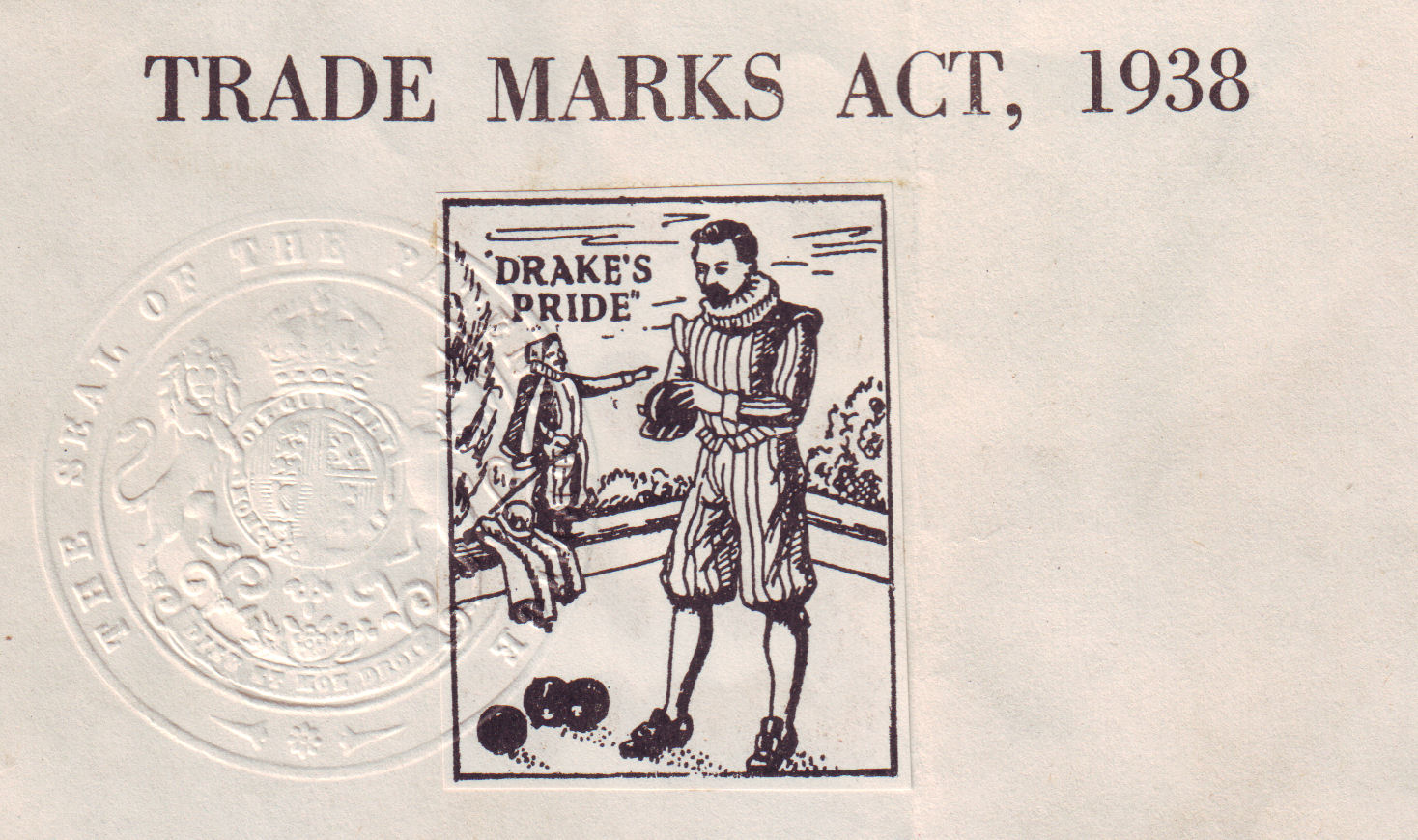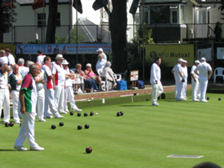Article 1 - History of Bowls
History of Bowls (Originally published
in 1997 and revised in 2009)
When Keith Hale, the Editor of World Bowls, asked me to
write about bowls manufacture, I wondered where to start. I think
it would be fair to say, that to have an understanding of the
current hi tech manufacturing processes used by to-days bowls
makers, some mention must be made concerning the history of the
sport.
Even though my company Drakes Pride can trace its history
back to 1820, via the Liverpool firm of Darlington's, and Thomas
Taylor's celebrated its
200thAnniversary in 1996, both
companies are but mere youngsters when it comes to the history of
the game.
Nobody ever speaks about the history of bowls without
referring to Sir Francis Drake, playing at Plymouth on
19th July 1588, when
Captain Thomas Flemming, advised that the Armada had been sighted
off the Lizard. Drake's response has gone down as one of the most
famous lines in history, "There is plenty of time to win the game
and thrash the Spaniards too". The original trade mark used by by
Drakes Pride alludes to this game.

However, almost 300 years earlier, the Southampton Bowls
Club green is reputed to have been laid and in regular use since
the year 1299. (The Southampton Club displays a
set of rules said to have been drawn up by Charles II, his brother
James, Duke of York, and the Duke of Buckingham in 1670 - the rules
are attached to the end of this
article). Chesterfield Bowling Club claims their
rink dates from 1294, and certainly in the early part of the
14thcentury Edward III banned
the playing of bowls so that the 'Bowmen of England' would practice
their archery. It does seem that bowls has not always been
associated with the gentle art as we now know it, and during its
early years the game was prohibited and quite high penalties could
be levied by magistrates, if anyone broke the
prohibition.
Charles I was also said to be a keen bowler so when in
1647 he was held at Carisbrooke Castle the owner turn the barbican
outside the Castle in to a bowling green for Charles I to play
on.
There is no real evidence as to the style of game,
although during the reign of Richard II, bowls was then referred to
as 'gettre de pere' presumably Norman French for 'jetter de
pierre' and so describes throwing a "stone". So there is not much
doubt that the original bowls are made from stone, they would be as
round as possible, nothing like the shape we now use. Sometime
after 1409, we do not know the actual date, bowls of wood were
used, made from Boxwood, Holly, Yew or Oak.
It is presumed that Lignum Vitae was introduced in making
of bowls during the
16thcentury, after the
discovery of the Santo Domingo in 1492. Santo Domingo is in the
Caribbean Sea, where the best Lignum Vitae is sourced, which is
still true to day. It is now very difficult
to obtain 'bowls grade' Lignum as the timber is on the UN CITES
register meaning that it is protected. Bowls making requires a tree
with heart wood approx. 150mm in diameter. Trees of the size for
such heart wood are not being harvested. So the best Lignum bowls
are now produced by reclaiming well seasoned 'old' stock' Lignum,
which is short supply
According to anecdotal evidence, the introduction of bias to the
design of bowls seems to have been by accident. It in said that in
1522, Charles Brandon the Duke of Suffolk, whose bowl split in two
pieces on striking another bowl, then rushed into the house and
sawed off the spherical knob from the banister post, in order to
provide himself with a replacement bowl. The flat cut then caused
his substitute bowl to roll with a bias. Observing this effect, the
Duke experimented by curving his bowl around others. He passed on
his knowledge to his friends, and so, in the course of time,
biassed bowls came into general use.
Later, bias was produced by loading the bowls on one side
by inserting weights; some players think that this is still done
today. So it is, that even now we occasionally find bowls, which
have been brought in for renovation or re adjusting, that have
been loaded by inserting metal or load on one side of the
bowl.
To bias by loading in this manner in no longer permitted
by the rules and the bias is now produced entirely by the shape of
the bowl. In fact with the bowls made to to days very tight
specifications using computer controlled lathes means that such
loading would cause the bowls to perform erratically, a similar
problem to a car wheel that in out of balance. Further information
about bias will be covered in future articles.
Prior to 1871, the bias of a bowl was not stipulated and a
test of any kind was unknown. The bowls were entirely hand turned
and finished in the absence of any testing method, it was
impossible for bowls' turners to make bowls which could be
accurately matched, every bowl was different and indeed matching
bowls were not expected by the players. In the next article, I will
explain further, why 1871 was the significant point with regard to
bias testing.
The Rule of the game said to have been drawn up in 1670. Reading
them I would suggest that the game of bowls described is more akin
to Crown Green than Lawn / Flat Green as it seems to indicate a
roaming jack although Federation Bowlers might also claim it is
closer to their version of the sport:-
The game to consist of five or seven points as may be agreed
upon by the party engaged. Four or six bowlers constitute a
set.
1. The party who has the highest die shall lead the Jack,
keeping his foot upon the trig, [the mat or footer"which must be
placed at least one yard from the verge of the green.
2. Whoever shall once throw the Jack off the green, shall lose the
leading of the Jack to their opponents, and shall be obliged to
follow the Jack so led by their opponents, or adverse party.
3. At the commencement of every end, the trig shall be places
where the Jack was taken up, or three strides wide of it in any
direction before the Jack be thrown, provided by so doing the cast
be not less than thirty yards.
4. If the Jack be bowled off the green, there shall be a fresh
cast, and the same party again lead.
5. If a bowl, whilst running, be stopped by the adverse party,
it shall be laid close behind the Jack.
6. If any bowler do take up the Jack before the cast or casts
won be granted, he shall lose the cast to the adverse party.
7. If any bowler who lieth all, i.e. who is nearest the Jack, do
take up the Jack or cause the same to be taken up before his
opponent hath thrown the last bowl, his side shall lose the cast
and the lead shall begin again.
8. If any bowler who lieth all do take up the Jack or cause the
same to be taken up before his own partner hath thrown his last
bowl, he shall lose the benefit of that bowl.
9. If any bowl do lie between the Jack and the bowl that is to
be measured, or the Jack leaneth upon the bowl, or the bowl upon
the Jack, it shall be lawful to bolster the bowl or Jack, and to
take away the bowl which hindered the measuring, provided it doth
not prejudice the adverse party in so doing. If it shall appear to
the spectators (being no bettors), the adverse party was prejudiced
thereby, although the bowl did not win, yet the benefit thereof
shall be lost.
10. If in measuring it shall appear that the bowl or Jack was
removed, or made worse by the measurer, the cast so measured shall
be allowed to the adverse party.
11. If any bowler bowl out of turn, his bowl may be stopped by
the adverse party, but not by him who delivered the same.
12. If any bowl be stopped while running, or touched by its own
party, it shall be taken away.
13. If any bowler deliver his bowl or bowls not touching the
trig with his foot, it shall be lawful for the adverse party to
stop the same whilst running and make him bowl it again; but it
shall not be lawful for him that bowls it to stop it.
14. If any bowler who lieth all do take up a bowl or bowls
before the adverse party hath granted him, the cast shall be lost,
and the Jack shall be thrown again.
15. No cast shall be measured before all bowls are bowled.
16. If he that is to throw the last bowl do take up the trig, or
cause it to be taken up, supposing the game to be won, or that he
shall do some hurt, the same bowls shall not be bowled that cast or
end, for the trig once taken up shall not be set again.
17. If any running bowl be stopped, or touched by a spectator,
not being a bettor, whether it be to the benefit or hindrance of
the caster, the same bowl shall take its chance and lie.
18. If a bowl be moved out of its place by the party that bowled
the same at any time before the cast be ended, the same shall be
cleared away by the adverse party.
19. Keep your temper! and remember he who plays at bowls must
take Rubbers.
© Peter N. Clare 2009 © E.A. Clare & Son Ltd. 2018 -
reproduction of article allowed only with permission from E.A.
Clare & Son Ltd.

